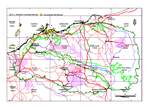Click on images
to enlarge



Photographer: B.R. Maslin

Photographer: B.R. Maslin
, Cleaverville, G.F. Craig_sml.jpg)
Photographer: G.F. Craig

Photographer: B.R. Maslin

Photographer: M.W. McDonald
, BRM 5745, lab photo by Fiona McCallum ADJUSTED_sml.jpg)
Seed from one herbarium voucher. Scale in mm. Photographer: F. McCallum.
Botanical name
Acacia coriacea DC. subsp. coriacea, Prodr. 2: 451 (1825)
Common name
Wirewood and Dogwood
Description
Dense, bushy, spreading shrubs or small trees 1-3 (-4) m tall (the branchlets and phyllodes not pendulous), occasionally prostrate. Bark grey, fibrous and longitudinally fissured on main trunks. Branchlets silvery sericeous (hairs short, straight and closely appressed) but becoming glabrous with age. New shoots citron-sericeous. Phyllodes linear to very narrowly elliptic, 9-22 cm long, 2-7 (-8) mm wide, coriaceous, mostly erect, straight to shallowly or moderately recurved, emitting an unpleasant odour when crushed, with minute, silvery appressed hairs except oldest phyllodes sometimes glabrous, silvery green to grey-green or sub-glaucous; with numerous, parallel, closely-spaced, fine nerves of uniform prominence or more commonly the central nerve slightly more pronounced than the rest; apex acute to obtuse, innocuous. Gland indistinct, on upper margin of phyllode 1-4 (-6) mm above pulvinus. Inflorescences simple, normally 2 per axil with a new vegetative bud initiated within the axil or the peduncles, occasionally some rudimentary racemes present (0.5-2 mm long); peduncles 4-10 (-13) mm long, densely silvery (rarely light golden) sericeous but hairs often sparse or sometimes absent when in pod; heads not showy, somewhat obscured by the phyllodes, 8 mm in diameter when fresh, creamy yellow to pale lemon yellow, 30-40-flowered. Flowers 5-merous; calyx ¼-½ dissected. Pods moniliform, (5-) 8-28 cm long, 5-10 mm wide, coriaceous to woody, either coiled and twisted as in subsp. pendens or openly curved (into a half or full circle) and not twisted, striate with often obvious longitudinal nerves, minutely silvery sericeous but hairs becoming sparse or absent with age. Seeds longitudinal in pods, obloid to ellipsoid, turgid or compressed, 5-7 mm long, 3-5.5 mm wide, sub- shiny, dark brown to black; aril bright orange and conspicuous, normally covering 1/3-½ of seed.
Characteristic features
Dense, bushy, spreading shrubs or small trees (the branchlets and phyllodes not pendulous), occasionally prostrate. Bark fibrous and longitudinally fissured. Branchlets silvery sericeous but becoming glabrous with age, not pendulous. New shoots citron-sericeous. Phyllodes linear to very narrowly elliptic, long and narrow (mostly 9-22 cm x 2-7 mm), mostly erect, coriaceous, silvery green to grey-green or sub-glaucous, finely multi-nerved. Inflorescences mostly simple, rudimentary racemes few; peduncles 4-10 (-13) mm long, densely sericeous when in flower; heads not showy, creamy yellow to pale lemon-yellow. Pods long (mostly 8-28 cm), moniliform, coriaceous to woody, either twisted and coiled as in subsp. pendens or openly curved (into a half or full circle) and not twisted, striate -nerved. Seeds partially enclosed by a conspicuous yellow or orange aril. Grows on coastal dunes.
Distribution and ecology
Occurs in northwest Western Australia in coastal areas (dunes and among rocks near water line) from Dirk Hartog Island in Shark Bay north to near Onslow, then the Dampier-Point Samson area of the Pilbara; also found on Dolphin, East Lewis and Enderby islands in the Dampier Archipelago, and Airlie, Barrow and Thevenard islands north of Onslow. Acacia coriacea subsp. coriacea tends to respond to fire by advantageously resprouting very slowly. However, in situation where the habitat is heavily infested with the transformer weed Buffel grass (Cenchrus ciliaris), such as on the coastal dune fringing Nickol and Regnard Bays down to the Fortescue River mouth, the fire response regeneration in subsp. coriacea is extremely poor and typically the plants succumb and do not even regenerate from seed.
Flowering and fruiting period
Flowers mostly between May and July. Pods with mature seeds occur between August and November.
Variation
While most plants are dense, spreading but erect shrubs, they are sometimes prostrate. The pods are variable in both width and in the degree to which they are twisted or coiled, as noted in description above.
Taxonomy
Acacia coriacea comprises two subspecies, subsp. coriacea and subsp. pendens, both of which occur in the Pilbara. Apart from occurring further inland and normally along watercourses, subsp. pendens differs from subsp. coriacea in that it grows to a much taller tree with normally pendulous or sub-pendulous branchlets and phyllodes. The phyllodes of subsp. coriacea are often broader, not as prominently recurved and not quite as long as those of subsp. pendens; also, its pods seem variable, sometimes irregularly coiled and twisted as in subsp. pendens and sometimes simply curved as in A. sericophylla. While the two subspecies of A. coriacea are easily distinguished in the field they are sometimes difficult to tell apart on herbarium specimens. Until recently A. coriacea included a third subspecies, subsp. sericophylla, but this taxon is now treated as a separate species, A. sericophylla.
Key to subspecies
Dense, spreading shrubs or small trees 1-3 (-4) m tall, occasionally prostrate; branchlets and phyllodes not pendulous; phyllodes 2-7 (-8) mm wide, straight to shallowly or moderately recurved. Coastal dunes.
A. coriacea subsp. coriacea
Shapely trees mostly 3-10 m tall; branchlets and phyllodes normally gracefully pendulous or sub-pendulous; phyllodes 1-4 mm wide, shallowly to strongly recurved or sometimes shallowly serpentinous. Inland from the coast, normally along watercourses.
Affinities
Acacia coriacea is closely related to A. sericophylla and has some affinities with A. sibilans (see these latter two species for discussion of differences).
Notes
Indigenous people of the west Pilbara used Wirewood for making spears and shields. Ash produced from the wood was used with native tobacco (Nicotiana species) as a chewing quid.
Conservation status
Not considered rare or endangered.
Origin of name
The botanical name is derived from the Latin word coriaceus (leathery) in reference to the texture of the phyllodes.
